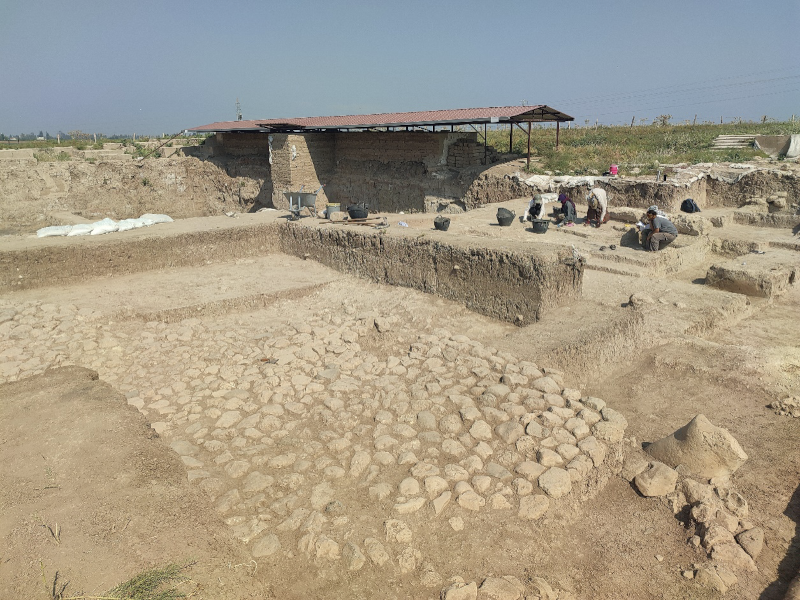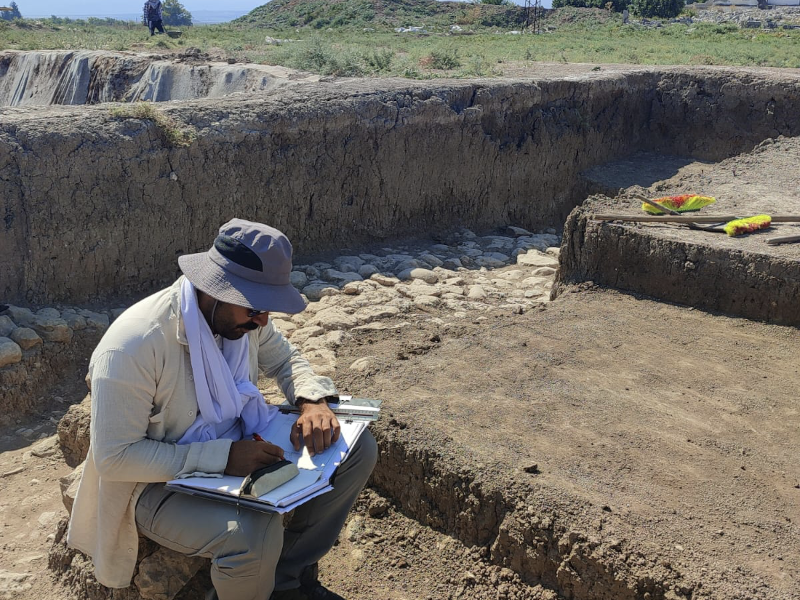
Tell Tayinat 2024: A Season in the Shadow of an Earthquake
Rubar Yavuz, 2024 Eric and Carol Meyers Fieldwork Scholarship Recipient
Tell Tayinat is a mound located 18 km west of Reyhanlı district in Hatay and 1.5 km east of the Orontes River. Southeastern Turkey experienced a major earthquake in 2023, which significantly impacted and damaged the Hatay province. Our excavation house was also severely damaged by the earthquake. This is why our excavation house consisted of containers and portables for the 2024 season.
Archaeology is not just about digging the soil. It is a space where human relationships are strengthened, where people come together to work towards a common research goal, and where individuals from different cultures meet. Even though this earthquake has caused major losses for people we know from the region, I still feel that we were able to reconnect, help each other while having a productive season.
The Iron Age layers have always fascinated me and have been an important focus of my thesis research. I would like to thank our excavation director for allowing me to excavate and study the Iron Age layers.
The Tell Tayinat excavation site was identified in 1933 by a team from the Oriental Institute of the University of Chicago, led by Robert J. Braidwood. In 1999, the mound was re-examined by a team led by Timothy P. Harrison, and excavation began in 2004. During these excavations, Early Bronze Age and Iron Age layers were identified.
During the 2024 season, we woke up at 4:00 a.m., and the vehicle departed at 4:30. Of course, these times shifted based on the sunrise. I was excavating a square in the Iron Age layers, following a stone pavement that had already been exposed in the 2022 season. From the moment it was uncovered, this stone layer indicated the extent of its damage. The surface soil extended to a depth of approximately 0.35 m. I was aware that I was conducting an excavation of surface soil, yet I was still careful not to miss any artifacts. Over the course of about a month, ceramic and basalt fragments were uncovered.
Our excavation used the locus-lot system, which meant we divided the area into square sections and excavated piece by piece. The main objective in the area I was working on was to follow a specific pavement. The most striking aspect for me was the artifacts located just above the floor. One seal, dated to the Assyrian period, was found directly on this stone pavement. After documenting the artifact, it was removed. Archaeology, in a sense, is about concealing all emotions, I managed to calm the excitement I felt inside though I was very happy that it was uncovered. After cleaning in the dig house it was confirmed to be an Assyrian seal with the image of a quadruped. There was some discussion of what animal it could be; many thought it was a lion, though some thought it was a type of composite animal. After this find, it was decided that expanding the excavation area further would be beneficial. While doing so, a bulla was found on this stone floor. This artifact was also dated to the Assyrian period.

End of season photo of my square
So, this floor was either built during the Assyrian period, or it predates them, with the Assyrians having walked on it. Despite the damage in the area I was excavating, this layer belonged to the Assyrians.
A gravelly layer made of hard soil and nari was encountered in the north of the area. This layer indicated that we had transitioned to a second phase. This gravelly layer extended beneath the stone floor. After documenting two stones from the stone pavement, they were removed, and a bronze armor scale was found beneath the stone floor. The Neo-Assyrian artifacts and related late Iron Age ceramics suggest that this layer was part of the Neo-Assyrian settlement in Tayinat, which was incredibly exciting to excavated and reveal.

In conclusion, this season’s excavations were both enjoyable and tiring, but that is archaeology! I would like to express my gratitude to ASOR and Eric and Carol Meyers for providing this fellowship. Thanks to this fellowship, I was able to attend Tell Tayinat excavations, expand my research on the Iron Age, and make new friends.
For more information about the Tayinat Archaeological Field School visit here.

Rubar was born in 1995 in the province of Mersin. He completed his primary, secondary, and high school education in Mersin. In 2017, he enrolled in the Archaeology department at Van Yüzüncü Yıl University. He graduated with honors in 2021. He was accepted into a master’s program at the same university, where he is currently continuing his studies. He participated in 17 different excavations focused on the Iron Age. He has conducted research on burial traditions of the Iron Age and is writing his master’s thesis on these burial practices.
Latest Posts from @ASORResearch
Stay updated with the latest insights, photos, and news by following us on Instagram!
American Society of Overseas Research
The James F. Strange Center
209 Commerce Street
Alexandria, VA 22314
E-mail: info@asor.org
© 2025 ASOR
All rights reserved.
Images licensed under a Creative Commons Attribution-NonCommercial-ShareAlike 4.0 International License




